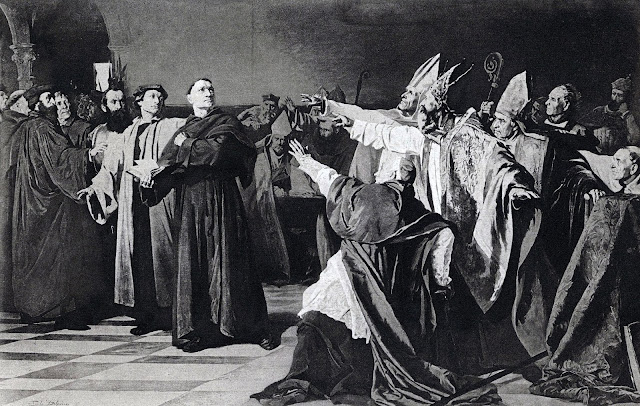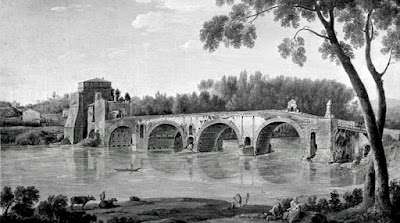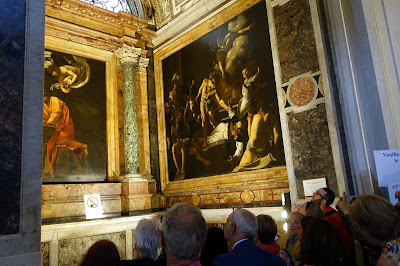On this the 500th anniversary of the
day Martin Luther posted his rebuke to Catholicism, his "Ninety-five
Theses" (October 31, 1517), we recommend an itinerary reflecting
Luther's visit to Rome, 6 or 7 years earlier.
 |
| Luther confronting the Catholic hierarchy |
That four-week visit to Rome was crucial to Luther's observations of the excesses of Catholicism. For a brief summary of his trip, see the the write-up of scholars Ron and Abby Johnson, St. Mark's Lutheran Church, Springfield, VA. While this was a seminal period for Luther, the details of his visit remain sketchy, even the dates, as the Johnsons point out. Nonetheless, we think the following itinerary will satisfy those interested in this figure critical to modern religious thought.
 |
| Luther's first view of Rome could have been from this spot on Monte Mario. St. Peter's dome would not yet have been constructed. |
Monte Mario: Luther
described his first sight of Rome as being from the "mountain"
outside the city walls. He is supposed to have said on his first look, "Holy Rome, I salute thee." Of course, years later he said, "If there is a hell, Rome is built over it."
The city looked very different in the early 1500s than it did even at the end of that century, and of course very different from today, although the views would have been stupendous, as they still are. Rome in the early 1500s was in the midst of an enormous church building spree. The city was coming out of its "irrelevance" during the Middle Ages. The population had grown to over 50,000 from a low of about 12,000, after being almost one million during the Roman Empire.
Luther would have seen the beginning of the Renaissance, though not its
flowering. Construction of the modern St. Peter's began in 1506. In 1508
Michelangelo began painting the Sistine Chapel. And Luther came before the 1527 Sack of Rome. We've always found Monte Mario great 'trekking' and recommend it as a starting point for an itinerary for those who can handle the moderate heights and walking. It's 1.2 miles from Ponte Milvio on the north bank of the Tiber to the entrance to the walk up Monte Mario, and less than a mile (and about 400 vertical feet) up to the top of Monte Mario (Lo Zodiaco).
The city looked very different in the early 1500s than it did even at the end of that century, and of course very different from today, although the views would have been stupendous, as they still are. Rome in the early 1500s was in the midst of an enormous church building spree. The city was coming out of its "irrelevance" during the Middle Ages. The population had grown to over 50,000 from a low of about 12,000, after being almost one million during the Roman Empire.
 |
| The via Francigena on Monte Mario. Where we encounter 4 British pilgrims on their way from Orvieto to St. Peter's. |
Via Flaminia: From
Monte Mario, it appears Luther came back down to via Flaminia, rather than
approach St. Peter's, as do today's pilgrims on the via Francigena (St. Francis's way). All pilgrims from the north would have
walked along via Flaminia, which crosses into Rome over Ponte Milvio. While we find the modern via Flaminia interesting (much of it is on one of our itineraries in Modern Rome: 4 Great Walks for the Curious Traveler), it has little left of the medieval city.
Ponte Milvio: Luther would have crossed the Tiber at Ponte Milvio, where on October 28, 312 Constantine,
who later converted to Christianity, the first Roman Emperor to do so, defeated his rival Maxentius. The bridge retains its medieval style, though it's mostly known now for lovers who put padlocks on its rails. Once
across the bridge, it's about a two-mile walk to the northernmost entrance to
the city, Porta del Popolo, and the church for which it's named.
 |
| Ponte Milvio. Part of the 14th century toretta (little tower), which Luther would have seen, is still standing. |
Porta del Popolo: Today's
highly decorated, enormous "porta"--city gate--is vastly remodeled from the smaller porta Luther came through. The porta had been built in the
1400s, as had the renovated church (1477), but on a smaller scale than they
would have once rebuilt and remodeled.
 |
| Inside Santa Maria del Popolo today - with crowds viewing the Carravagio paintings. |
There is some debate over whether Luther stayed in the rooms adjacent to the church. They would have been the only lodging in Rome belonging to an Augustinian order. There is agreement that he either stayed at or visited Santa Maria del Popolo - so we've kept it on the itinerary. Luther's journey was connected to disputes between the Observant and Conventional monasteries of the Augustinian Order. Luther belonged to the Germanic Observant group, and Santa Maria del Popolo belonged to an order of Observant Augustinians as well, although Luther seems to have rejected the lavish meals he was served at whatever monastery at which he lodged.
We recommend a two-part itinerary, and you can end part one at Piazza del Popolo. You can make a very un-Luther like stop at the famous cafe Canova, where Director Federico Fellini had his morning coffee.
Scala Santa: Even though his 95 Theses rejected the concept of indulgences, Luther, on his trip to Rome, "was as eager to rack them up as anyone," according to one scholar. "He even regretted that his parents were not still alive so he could earn a few for them." (For more on what indulgences meant to Catholics, and Luther in particular, see Tom Browning's piece.) Luther earned indulgences for ascending these steps on his knees, an act you can still see pilgrims performing. One story states that Luther said, "Who knows whether this is true?" when he got to either the top of the stairs, or possibly when he quit half-way through. Again, the details of his trip are sketchy, but it is clear his doubt was developing. The Scala Santa, supposedly the stairs Jesus climbed on his way to his trial with Pilate and that were later transferred to Rome, are across a road (now) from San Giovanni in Laterano. If you are doing the seven churches, described below, you can add these to your itinerary when you visit San Giovanni.
 |
| San Giovanni in Laterano, rebuilt after Luther was there. |
 |
| Luther would have seen the 7th century mosaics of St. John the Baptist at the San Giovanni baptistery |
While you are at San Giovanni in Laterano, don't miss the Lateran Baptistry behind it, which Luther must have visited It is one of the oldest buildings in Rome, dating to the 4th century, although substantially remodeled over the years, including by Borromini (post-Luther). Luther would have seen an exterior much like the one today, however, and much of the same interior, since Borromini kept most of the existing building. And it's one of my favorites in Rome.
Here's a suggested route for the seven churches: Start with Santa Maria Maggiore, the most central of the seven churches. Walk 1.6 miles to San Lorenzo (outside the walls). From San Lorenzo, walk 1.2 miles to Santa Croce in Gerusalemme (which is inside, and abutting the walls); then .9 miles to San Giovanni in Laterano (again, abutting the walls - you'll walk along the inside of the walls for this stretch; it was part of one of RST's wall walks--there's a google map here to guide you on that walk); then 2.6 miles to San Paolo fuori le mura; and from there, the walk along via Sette Chiese to San Sebastiano (again, outside the walls), 2-plus miles due east. To add St. Peter's to the walk, begin with St. Peter's and then walk to Santa Maria Maggiore, 2.3 miles. Total: about 10.5 miles.
 |
| San Sebastiano. 1610 facade. |
More specific directions and a slightly different order of churches are available here. Some suggest a modern version that substitutes the sanctuary Divino Amore, 9 miles from San Giovanni, for San Lorenzo. I'm a San Lorenzo fan and, of course, Divino Amore would not have been on Luther's route. And, if you go to Divino Amore, take a bus.
Dianne




No comments:
Post a Comment